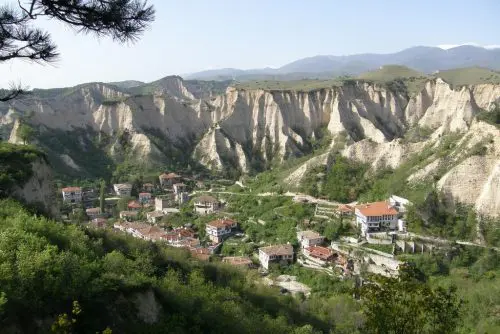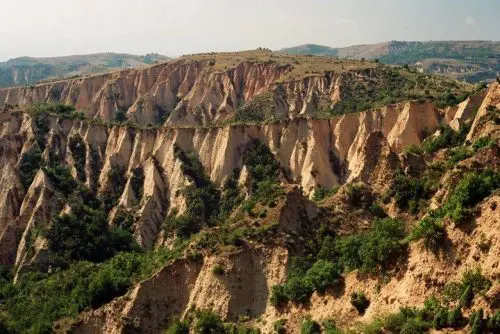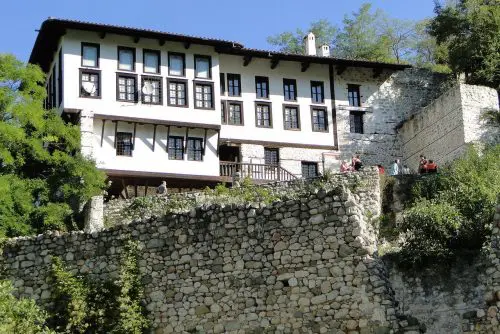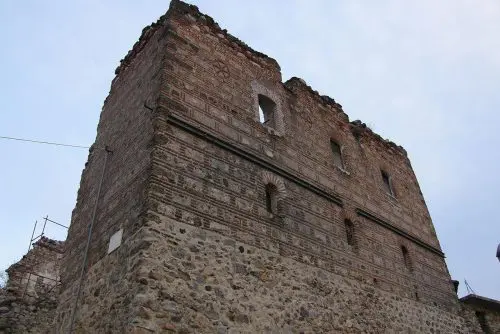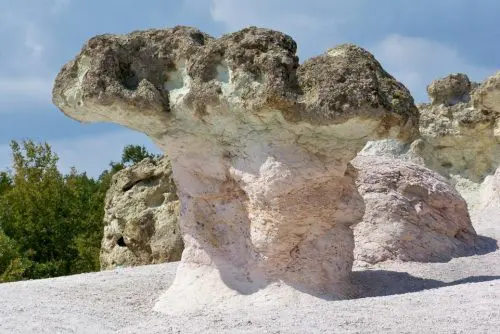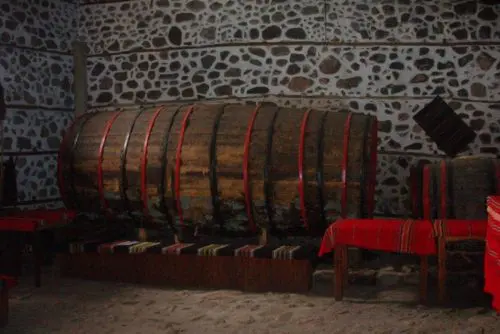For those of you who haven’t heard, Melnik is the smallest town in Bulgaria, known for its rich history, traditional wine production, and one-of-a-kind natural environment. It is located at the southwestern foot of Pirin mountain, thus providing an amazing view of its steep slopes along the Struma valley.
Apart from its cultural sights and well-developed wine tourism, the small town is also a perfect tourist destination for sightseeing if you’re a nature lover. So today, we will guide you to the Melnik Pyramids – some of the most stunning rock formations on the Balkan peninsula.
Melnik and Its Earth Pyramids – The Basics
Melnik is a typical small mountain town with a population of 385 people, located in a picturesque area in southwest Bulgaria, 22 km southeast of Sandanski, Blagoevgrad region.
It is located in close proximity to some of the most popular resorts in the Pirin mountain range of Bulgaria, including Bansko, Rozhen village, and the town of Sandanski. This makes the beautiful town both a perfect primary destination and an exciting day trip no matter where in the Blagoevgrad province you’re staying.
The small attractive town in national revival style is nestled in the embrace of Pirin mountain – one of the most beautiful mountains in Bulgaria. Close to Melnik, there is one unique natural phenomenon – the sedimentary rocks of varied shapes towering near the settlement.
A direct path from the town leads to the sight of Melnik Earth Pyramids – a wonderful place on our list of Bulgarian sights, which every Bulgarian has to visit at least once in a lifetime.
The Melnik pyramids are of great interest to Bulgarian and foreign tourists, and this is not by accident. Such a natural phenomenon is a rare occurrence in the entire Balkan Peninsula, as well as proof of the power of nature and its capabilities to create such beautiful landmarks.
These pyramids are one of the most impressive natural landmarks in Bulgaria and one of the country’s most visited rocky pyramids.
The pyramids impress with their vast dimensions, their steep slopes, and the breathtaking views from above, and due to these reasons, they are so magnetic for the tourists. This fact has imposed the need to construct holiday houses and other buildings in Melnik to accommodate the flow of incoming tourists, curious to see the impressive natural phenomenon.
In addition to the rocky pyramids, the region can reveal a variety of other rock formations, such as rock mushrooms, earth needles, erosion cones, and other natural formations with unusual forms and looks.
What is the Geological Structure of the Melnik Earth Pyramids?
The Melnik Earth Pyramids, by themselves, are a fascinating natural phenomenon that attracts the interest of thousands of tourists from Bulgaria, the European Union, and the whole world. The pyramids in Melnik are considered to have formed this way after a process of erosion of clay soils in the region.
The Melnik Earth Pyramids are rock formations with vertical walls extending over an area of 50 sq.m. They are made of rock-sand material. From a geological point of view, the region of Melnik consists of gray-white Pliocene sands mixed with clayey layers.
This earth layer of clay and sand actually was the sludge at the bottom of an ancient shallow lake, with tremendous size, which existed 4-5 million years ago. It was located in today’s hollow of Sandanski and Petrich.
After a long time, due to the folding of the earth’s mass, caused by the movement of the continental plates, the mountain massifs Pirin, Ograzhden and Belasica occur. As a result of their rising, the waters of the ancient lake start to drain in the southern direction.
Rock material began accumulating in the newly formed hollow, which started sliding down with the help of the local mountain rivers and streams. Thus, on the deposited sandy layer, which has remained from the lake, was formed a thick driftage layer with a thickness of 500-600m, made of very slightly bonded reddish sedimentary rocks.
So, with thousands of years passed, sedimentary rocks have accumulated on this earth layer, consisting of rock-sand material, coming from Pirin mountain, whose thickness reaches 120m. Finding its way through the accumulated rock mass, the running mountain waters formed deep valleys and glens, which caused the creation of various rock forms.
Furthermore, besides the movement of water, under the influence of corrosion processes caused by the power of winds, storms, as well the cold and hot climate of the region, interesting natural formations have occurred, resembling giant mushrooms, ancient pyramids, church domes, swords, and others.
The height of the Melnik Earth pyramids reaches up to 100 m. A characteristic feature of this natural formation is that the slopes and alpine ridges of the pyramids are made of sand, and there are places where the pyramids are almost entirely vertical.
Although, at first sight, the pyramids look like there is nothing on them, the highest point of the Melnik Earth pyramids has a rich flora. It includes plants such as deciduous trees, bushes, and various types of grass.
The smallest town in Bulgaria also has a fauna heavily influenced by the geological phenomenon. Usually, the Melnik Earth pyramids are divided into three sections – Melnik, Rozhen, and Karlanovski sand pyramids.
An important fact is that the Melnik earth pyramids are in the process of being shaped, and their appearance and forms are changing over time.
In 1960, the Melnik pyramids were first declared a natural landmark. The most frequently visited group of the Melnik pyramids is located near Rozhen monastery. It is easy to get there by taking the hiking trail, which starts from the town of Melnik and leads to the Rozhen monastery.
The Melnik pyramids are a frankly unique creation of Mother Nature. They look like natural sculptures made by human hands, revealing picturesque views of the entire region. The structure of the Melnik pyramids is quite varied – there are many different shapes and forms, some of which totally worth a photo hunt from the Rozhen monastery.
A curious fact about the sandstone pyramids is that they are in a continuous process of natural shaping, and their form and appearance change over time under the impact of the natural processes. The natural phenomenon of the Melnik pyramids fascinate every visitor and awakens the imagination of the tourists.
For a long time, the pyramids in Melnik have ignited the imagination of every tourist who has seen them. In appearance, they can be likened to a variety of things. The pyramids look like mountain peaks, alpine ridges, and rock mushrooms.
Some people even say they look like Egyptian temples and pyramids, obelisks, domes of Gothic churches, even swords, minarets, haystacks, and others.
Another group of pyramids, the most popular ones in Melnik, is located in Karpanovo village, Blagoevgrad region. They are four in number, and they are pretty impressive. They look like blades or obelisks, with a height of more than 100 meters.
They have bare steep slopes without vegetation; their peaks have a flat surface. They are covered with low grasses, and trees can be seen in some places. Their characteristic rock “hat„ is why the sand-rock material of the whole rock structure is solid and resistant to the natural destructive processes.
What is Melnik also Famous For?
Despite its small size, Melnik impresses with its western architectural style from the Bulgarian revival period. Its popularity is not limited only to the fascinating sand pyramids.
The town also has 96 buildings from the revival period that have been declared cultural monuments. In fact, the whole town of Melnik is an architectural reserve. Moreover, it is located a few kilometers away from the Rozhen monastery – the biggest Orthodox temple in Pirin mountain.
Other Interesting Sights to See in Melnik
In addition to the famous sand pyramids, Melnik can offer more places to intrigue every tourist. As an official architectural reserve settlement, it hosts some artifacts of global importance, such as ancient towers and relics from the Middle ages.
You can plan your trip around town by visiting the local Tourist information center, and you can enjoy some rather convenient public transport options between Melnik and other nearby towns.
So, below you will find a few ideas to round out your visit to the Melnik earth pyramids by exploring other interesting places around town.
The Kordupolova House
An interesting fact about this house is that it is the biggest house from the revival period in size on the Balkan Peninsula. The house is also known as the Tzintzarova house, located in the eastern part of Melnik.
It is near the Bolyarska and Pashova houses. It was built for wine storage, as well as for wine production and trade.
The Kordupolova house has been preserved in its original form until today. Currently, it has become a museum house with four floors in total. It was built according to the traditional revival architectural model.
It consists of a ground floor with a basement dug in the rock for wine storage and a living floor that serves as a residence with a summer terrace. Two of its floors are made of stone.
In addition, there is an exhibition where gigantic barrels for Melnik wine are presented, as well as murals and carvings in Venetian style, stained glasses, and original cupboards. Your visit will take you all the way around the house, including its wine cellar, ground floor, and summer terrace.
The wine cellar itself is a rock tunnel with a length of 150 m. It is equipped with a ventilation system and a unique system of narrow and low corridors. The biggest barrel in the wine cellar of the museum house can bear 12,5 tons. It is considered that the cellar can store up to 300 tons of wine.
The Kordupolova house was owned by a wealthy Greek family of merchants called Kordupolous. Manolis Kordupolous was actually the last known member of the family. He received specialized education in wine production in France. Subsequently, after returning to his native lands, he developed the wine industry in Melnik, introducing the modern way of quality wine production.
Another curious fact about him is that he gave shelter in his house to Yane Sandanski in the period preceding the Balkan War. The Kordupolova museum house is included in the 100 national tourist sites list and is one of the most intriguing historical landmarks to see in the Blagoevgrad region.
The Bolyarska House
The Bolyarska house is another example of the traditional architectural genius that reigned in the town of Melnik during the middle ages. It was built in the first half of the XIII century.
It is a symbol of architectural art in residential buildings during the Bulgarian medieval period, and the house was declared a cultural site of national importance.
During the middle ages until the XV century, it was situated in the center of the suburb of Melnik. After that, the Bolyarska house was used as a home until the beginning of the XX century. Finally, it was left to ruin, but the ruins are still worth appreciating!
The Rock Mushrooms near Rozhen
To the south of the Rozhen village are located thousands of rock mushrooms of large and small sizes, which are an impressive attraction for tourists.
Anyone who wants to learn more about the phenomenon called Melnik earth pyramids can visit the Tourist Information Center in the town of Melnik for more information about this landmark and the entire region.
The rock mushrooms near Rozhen are easily approached from the nearby monastery and perfectly complement your larger tour among the Melnik earth pyramids. Moreover, the giant mushrooms are formed primarily near Rozhen, making them a unique part of the natural landmark area.
Melnik Wine Tourism
Another popular thing about Melnik is its developed wine tourism and centuries-old traditions in wine production, dating back to Ottoman rule and the Bulgarian revival period. An example of a place where everyone can taste authentic Melnik wine is the guest house Shestaka.
This house offers an authentic revival atmosphere and selected wine varieties from the famous family of producers of wine in the region. Thanks to their production, we can enjoy the aromatic Melnik wine, served near the bedrock wear rock formations.
Churches, Monasteries, and Museums
Another interesting fact is that the small and beautiful town of Melnik has gathered eight churches and monasteries, one historical museum, and many works of architectural art of the times of the revival. All of them are well-preserved and comfortable to explore all year round, thanks to the mild Mediterranean climate of the area.
Despite its small size, in Melnik, you can’t be bored. There are places for both natural beauty lovers and gourmet travelers who want to taste something authentic and Bulgarian.
